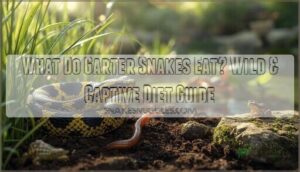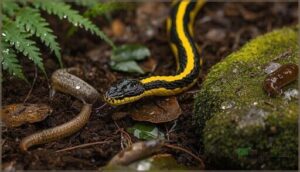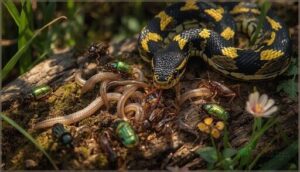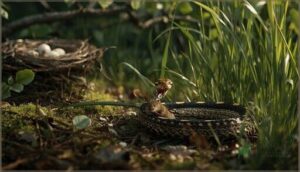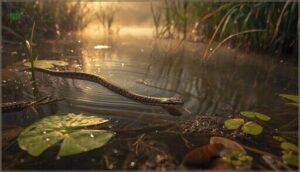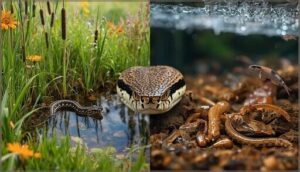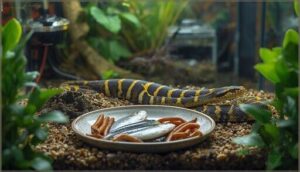This site is supported by our readers. We may earn a commission, at no cost to you, if you purchase through links.
That slender snake weaving through your garden isn’t picky about its next meal—it’s an opportunistic hunter built to tackle whatever wriggles, swims, or crawls within reach.
Garter snakes are strict carnivores with surprisingly diverse tastes, from earthworms and slugs to fish, frogs, and even small rodents. Their adaptable palate shifts with the seasons and local prey availability, making them highly effective predators across varied habitats.
Understanding what fuels these common snakes reveals not just their dietary habits, but how they’ve mastered survival in environments ranging from wetlands to backyard gardens.
Table Of Contents
- Key Takeaways
- What Do Garter Snakes Eat?
- Terrestrial Prey of Garter Snakes
- Aquatic Prey and Feeding Habits
- Factors Influencing Garter Snake Diet
- Feeding and Nutrition in Captive Garter Snakes
- Frequently Asked Questions (FAQs)
- Why do garter snakes smell bad?
- Do garter snakes eat mice and voles?
- Do garter snakes bite and are they dangerous?
- What is a garter snakes’ favorite food?
- Is it good to have garter snakes in your yard?
- Do garter snakes eat mice?
- Does a garter snake bite hurt?
- What is a garter snake’s favorite food?
- What attracts garter snakes to your house?
- Are garter snakes good to keep around?
- Conclusion
Key Takeaways
- Garter snakes are strict carnivores with adaptable diets that shift based on habitat and season, consuming earthworms and slugs in terrestrial areas while targeting fish, tadpoles, and frogs near water sources.
- Their prey selection changes with age, as juveniles start with small insects and baby amphibians while adults can tackle larger prey like small rodents and birds when opportunities arise.
- These snakes serve as valuable natural pest controllers in yards and gardens, eating slugs, insects, and small rodents that damage plants while posing minimal danger to humans.
- Understanding their wild diet helps both appreciate their ecological role in maintaining ecosystem balance and properly care for captive garter snakes through varied feeding schedules and appropriate prey selection.
What Do Garter Snakes Eat?
Garter snakes are strict carnivores that hunt live prey in their natural habitats. Their diet includes a surprising variety of small animals, from earthworms and slugs to fish and amphibians.
Understanding what they eat in the wild helps you appreciate their role in the ecosystem and care for them properly if you keep one as a pet.
Typical Diet in The Wild
In the wild, garter snakes are flexible hunters, adapting their diet to whatever prey is most abundant around them. You’ll find them eating earthworms, slugs, and insects in grassy areas, while those near water focus on fish, tadpoles, and frogs. Larger snakes may tackle small rodents when the opportunity arises.
Garter snakes are flexible hunters, adapting their diet to whatever prey is most abundant in their habitat
This diet adaptation reflects their important ecological role as predators of diverse prey. Understanding the subtopic details can help in organizing information about garter snakes’ eating habits.
Common Prey Types
Now that you know garter snakes adjust their menu based on location, let’s break down exactly what’s on the table. Their prey preferences span several food chains, and their hunting strategies rely on ambush and quick strikes. Here are the most common targets:
- Earthworms – A staple, especially for younger snakes
- Insects – Beetles, crickets, and grasshoppers
- Amphibians – Frogs, toads, and salamanders
- Fish – Small species in shallow water
- Rodents and small birds – Occasional meals for larger individuals
These feeding behaviors show exceptional predator avoidance isn’t always enough for smaller creatures.
Foods They Avoid
You won’t find garter snakes tackling large mammals or cracking hard-shelled prey—they lack the specialized teeth for that. They also steer clear of venomous prey and anything too big to swallow whole.
This prey avoidance reflects smart predator-prey dynamics: toxic foods and oversized targets simply aren’t worth the risk, keeping their reptile diet focused on manageable, safe nutrition.
Understanding the importance of clear science information is essential for analyzing their dietary habits.
Terrestrial Prey of Garter Snakes
Garter snakes spend much of their time hunting on land, where they find plenty of easy meals hidden in the grass, soil, and leaf litter. They don’t need to chase down fast prey—instead, they go after slow-moving or defenseless animals that won’t put up much of a fight.
Let’s look at the main terrestrial creatures that make up their diet.
Earthworms and Slugs
You’ll find earthworms and slugs at the heart of the garter snake diet, especially in damp earthworm habitats where moisture levels stay high. These snakes rely on keen senses and burrowing techniques to locate prey hiding in loose soil quality zones and leaf litter.
Slug predation happens most often when garter snake feeding habits align with:
- Surface hunting after rain
- Probing moss-covered ground
- Targeting sluggish, protein-rich invertebrates
This reptile diet provides essential hydration and energy.
Insects and Larvae
You’ll discover that garter snake feeding habits expand into insect nutrition throughout their lives, with crickets, grasshoppers, and beetles serving as essential protein sources during wild foraging. Larval feeding on mealworms and caterpillars aids young snakes when larger prey isn’t accessible.
Cricket diets and beetle prey become especially important in dry habitats, where these invertebrates offer concentrated nutrients that fuel growth and daily movement.
Small Mammals and Birds
When opportunities arise, garter snakes shift their mammal hunting strategy to capture mice, voles, and shrews near ground cover. These prey items support snake nutrition through higher caloric returns than invertebrates. Bird eggs and nestlings also factor into predator-prey dynamics:
- Prey capture relies on ambush tactics in low vegetation
- Small rodents offer concentrated energy for growth
- Avian predation peaks during nesting seasons in accessible habitats
Aquatic Prey and Feeding Habits
When garter snakes live near ponds, streams, or marshes, their menu shifts to include whatever swims or hops nearby. These snakes are surprisingly good swimmers and won’t hesitate to slip into the water for a meal.
Let’s look at the main aquatic prey that keeps them well-fed in wetter habitats.
Fish and Tadpoles
When you watch a garter snake near water, you’ll notice they’re skilled at aquatic foraging. Fish prey like minnows and tadpoles become prime targets, especially in wetland habitats where water levels make prey capture easier.
These snakes rely on ambush tactics near shorelines, with their reptile nutrition depending heavily on fish availability throughout the season. Tadpole hunting peaks when ponds are full, supporting essential snake nutrition needs.
Frogs and Salamanders
You’ll see garter snakes hunting frogs and salamanders most often during wet summer months, when amphibian hunting peaks near breeding sites.
These carnivores use prey capture skills adapted for moisture preferences, striking salamanders and newts alongside earthworms in humid zones.
Seasonal feeding patterns shift with rainfall—aquatic adaptation helps them exploit amphibian abundance when water brings fresh opportunities to shoreline habitats.
Prey Selection Near Water Sources
When you observe garter snakes near water edges, you’ll notice they exploit the boundary between aquatic and terrestrial environments with striking efficiency. Their snake foraging tactics include ambushing tadpoles and small fish while remaining alert to predator-prey dynamics.
Prey size selection favors manageable earthworms and snails, though wetland habitat dynamics and aquatic prey preference shift their hunting focus seasonally based on what’s accessible along shorelines.
Factors Influencing Garter Snake Diet
A garter snake’s diet isn’t set in stone—it shifts based on where the snake lives and what’s available to eat. The snake’s age and species also play a role in what it can catch and digest.
Let’s look at the main factors that shape what garter snakes hunt and eat.
Habitat and Prey Availability
Where you find garter snakes matters—a lot. Their microhabitat selection directly shapes prey distribution and foraging strategies. In wetlands, your local garter snakes feast on tadpoles and fish, while grassland populations rely heavily on earthworms and insects.
Habitat fragmentation disrupts this ecosystem balance, forcing environmental adaptation. Understanding snake behavior and wildlife ecology reveals how tightly prey availability steers their survival.
Age and Species Differences
As your garter snake grows, its diet shifts—a process called ontogenetic shifts. Juveniles start with tiny prey like baby amphibians and insects, while adults tackle larger fish and small mammals.
Species variations matter too: some northern garter snakes prefer fish, while others lean toward terrestrial prey. Geographic influences and local prey availability drive these dietary adaptations, shaping reptile nutrition and snake behavior across populations.
Seasonal Variations in Diet
Temperature effects drive major shifts in what you’ll find garter snakes eating. Warmer months above 20°C boost prey migration and activity—tadpoles, earthworms, and amphibians become easier targets.
In autumn, these snakes show dietary flexibility through adaptive feeding, favoring higher-fat prey to fuel hibernation.
Climate influence shapes reptile nutrition and diet across seasons, reflecting ecosystem balance and diversity while supporting snake behavior and habitat needs.
Feeding and Nutrition in Captive Garter Snakes
Keeping a garter snake healthy in captivity starts with getting the diet right. You’ll need to know which foods work best, how often to feed, and what nutrients your snake needs to thrive.
Let’s break down the essentials of feeding your pet garter snake.
Recommended Foods for Pets
You’ll want to offer your garter snake a balanced mix of prey that mirrors its natural diet while ensuring proper reptile nutrition and diet. Pet food options should be appropriately sized to prevent regurgitation, and variety promotes overall snake nutrition.
Safe captive diets include:
- Earthworms and appropriately sized feeder fish from parasite-free sources
- Frozen-thawed rodents like pinky mice to reduce injury risk
- Occasional insects for juveniles, with dietary supplements added when needed
Feeding Frequency and Schedules
Once you’ve selected the right foods, you’ll need to establish consistent meal timing for your garter snake. Feeding cycles depend on age and activity level.
Young snakes usually need meals every 5–7 days during warm months to support their rapid growth rates. Adults can wait 7–10 days between feedings.
Make dietary adjustments based on your snake’s body condition, seasonal changes, and individual appetite to maintain proper snake nutrition.
Nutritional Considerations and Health
Nutrient balance drives your garter snake’s long-term health. Offer varied prey—earthworms, crickets, small fish—to cover protein, fat, and mineral intake without creating deficiencies.
Watch for health indicators like steady weight, active feeding, and normal shedding cycles. Provide clean water for hydration needs, and consider occasional dietary supplements if your pet’s diet lacks diversity, ensuring peak reptile health and wellness.
Frequently Asked Questions (FAQs)
Why do garter snakes smell bad?
Garter snakes emit a musky odor through cloacal glands when threatened, releasing volatile compounds that irritate predators.
This musk production is a stress response and defense mechanism, not linked to their digestive system.
Do garter snakes eat mice and voles?
Yes, garter snakes eat mice and voles when they encounter them, especially larger adults.
These small mammals provide high-quality protein and energy, though they’re taken less frequently than earthworms or amphibians.
Do garter snakes bite and are they dangerous?
While they might nip if cornered, garter snakes pose virtually zero danger to you. Their weak venom affects only small prey, causing mild redness at worst—far more startling than harmful.
What is a garter snakes’ favorite food?
You’ll often find earthworms and slugs at the top of the menu for garter snakes.
Their prey preferences shift based on habitat—aquatic populations favor small fish and tadpoles over terrestrial invertebrates.
Is it good to have garter snakes in your yard?
Having these snakes in your yard offers natural pest control—they eat slugs and insects that damage gardens.
You’re supporting wildlife conservation in suburban areas while creating balanced habitats across North America.
Do garter snakes eat mice?
While they’re not mouseketeers in the traditional sense, garter snakes do eat mice—particularly young ones.
Small mammals provide protein and fat, especially in captive diets and wild habitats where rodent activity runs high.
Does a garter snake bite hurt?
A garter snake bite feels like a quick pinch or brief stinging sensation that fades within minutes. These non-venomous snakes rarely cause serious injury, though you may notice mild redness at the bite site.
What is a garter snake’s favorite food?
Earthworms rank as the top choice across most garter snake populations. You’ll find these snakes actively hunting worms in moist soil, drawn by their high protein content and easy capture.
What attracts garter snakes to your house?
Your lawn attracts garter snakes when it offers abundant prey like earthworms and insects, water sources, yard clutter for shelter, and warm spots for thermoregulation—all essential habitat features these reptiles seek.
Are garter snakes good to keep around?
Yes, garter snakes are beneficial to keep around. These non-venomous wildlife allies provide natural pest control by hunting slugs, insects, and rodents, fulfilling an important ecological role while posing minimal risk to human safety.
Conclusion
Think of garter snakes as nature’s cleanup crew—patrolling gardens and wetlands, they consume whatever crosses their path. What do garter snakes eat? Everything from worms and slugs to frogs and fish, adapting their menu to match their surroundings.
Whether you’re observing wild populations or caring for a captive snake, understanding their carnivorous appetite helps you appreciate how these adaptable hunters maintain balance in ecosystems while thriving in backyards and beyond.

